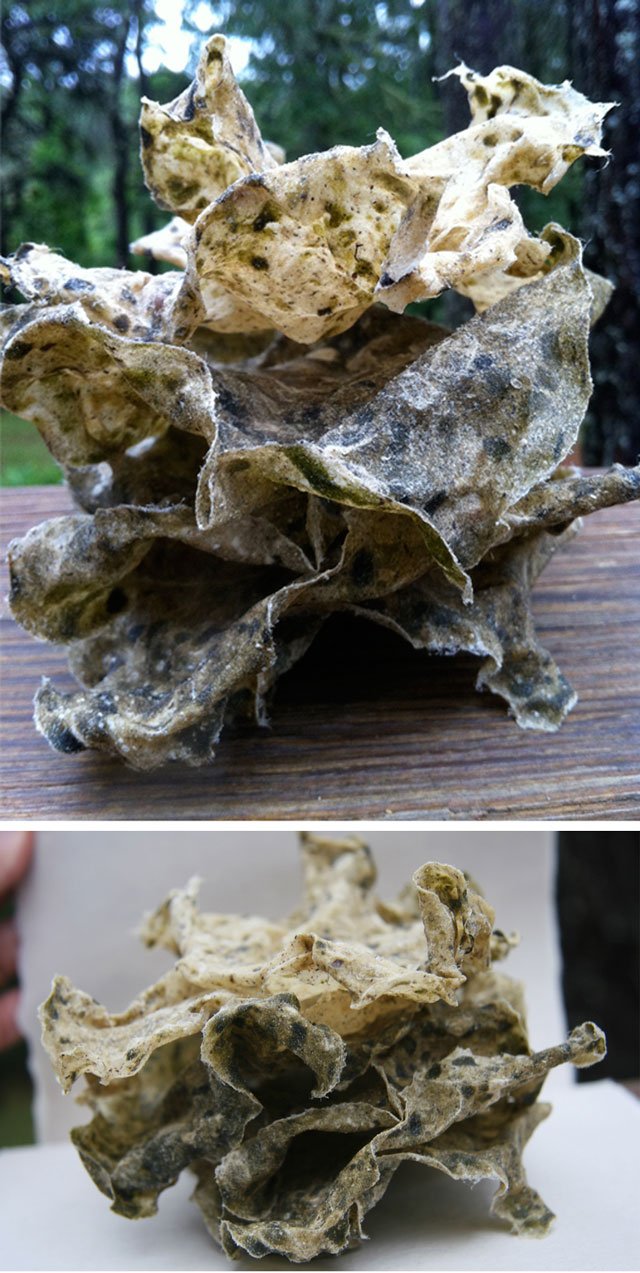Making Paper from Seaweed: Papermaking with Atlantic BioInvader Codium Fragile
papermaking plants seaweed "dead man's fingers"
"Papermaking with Atlantic BioInvader Codium Fragile" is a guest post by papermaking artist and sculptor Megan Singleton, who completed an artist residency in Chatham, MA. Originally featured on Aldo & Leonardo, (A Wilderness Science and Art Collaboration) these are Megan's musings on making paper and art from a common invasive seaweed on Cape Cod. And without further ado...
The relationships that exist within the natural world inspire me. A large part of my studio practice is exploring the materiality and transformative properties of plants, specifically I investigate invasive plants and their impact within the ecosystems they are invading. The first day I arrived on Cape Cod I encountered Codium fragile, commonly known as "Deadman's Fingers" or "Green Fleece". It is native to Pacific waters and was accidentally introduced to the Atlantic Coast in 1957, most likely from international shipping traffic. Part of the success of this plant's population boom is due to the fact the dominant herbivore in these waters, the Green Sea Urchin, does not prefer to eat it. MIT Marine Bioinvasion Fact Sheet As you can see below this plant dominates shorelines here in Chatham, washing up in heavy ropey masses. Its negative impacts on the ecosystem include choking out important native species such as eel grass, thus displacing marine fauna such as oysters and clams that inhabit the eel grass beds.
The papermaking process for me begins with exploring sites that are being affected by invasive species and collecting plants. The images above are from Cockle Cove in Chatham, MA. The following images and list will outline the process I used to create paper from these plants.
harvesting plant fiber seaweed invasive for hand papermaking
boiling seaweed plant fiber for hand papermaking
invasive plant fibers for papermaking
making paper by hand with plants
handmade paper from plants
1. Collecting Fiber on a Rainy Day at Cockle Cove
2. Collected Fiber is piled up and then sorted to remove the Atlantic Slipper Shells and their inhabitants. Detail of Codium Fragile connected to Atlantic Slipper Shell.
3. The fiber is then cut into about one inch pieces and cooked with Soda Ash. The Soda Ash is a caustic, which when cooked with plant materials separates the cellulose and non cellulose matter from the plant. This batch was simmered and cooked.
4. The fiber is then rinsed with fresh water. Rinsing removes the soda ash residue and non cellulose matter from the plant. Next this fiber was put into a blender to make a pulp slurry.
5. The pulp slurry is poured into a vat. Next sheets are pulled using a mould and deckle I brought from my studio. The sheets are couched onto interfacing as you can see in the bottom left. Detail of a freshly formed sheet on the mould.
6. After the sheets were formed I hand pressed them and dried them in a variety of ways. Above you can see some of the sheets were rolled onto a glass sliding door to dry.
7. This is one of the sheets after it dried and was peeled off the glass window.
The paper is surprisingly very strong considering it was not processed in a hollander beater and was only pressed with the weight of my body. The texture is almost waxy and the translucency is very appealing.
These images show a stack of 4 sheets that were allowed to air dry without restraint. They shrunk about 40% and are very strong. For those of you familiar with papermaking and processing pulp in a hollander beater, the fiber has similar qualities of a high shrinkage abaca, yet it was only processed for 30 seconds in a blender.
I also wanted to test the ability of the sheets to be wrapped around armatures. I found some cut up thorny branches in the nearby the salt marsh and lashed them together to make this form. This fiber has a lot of sculptural potential and I am excited to share my findings with members of the Department of Wildlife and Fisheries and the Papermaking community.
Visit www.megansingleton.com for more of Megan's artwork.








